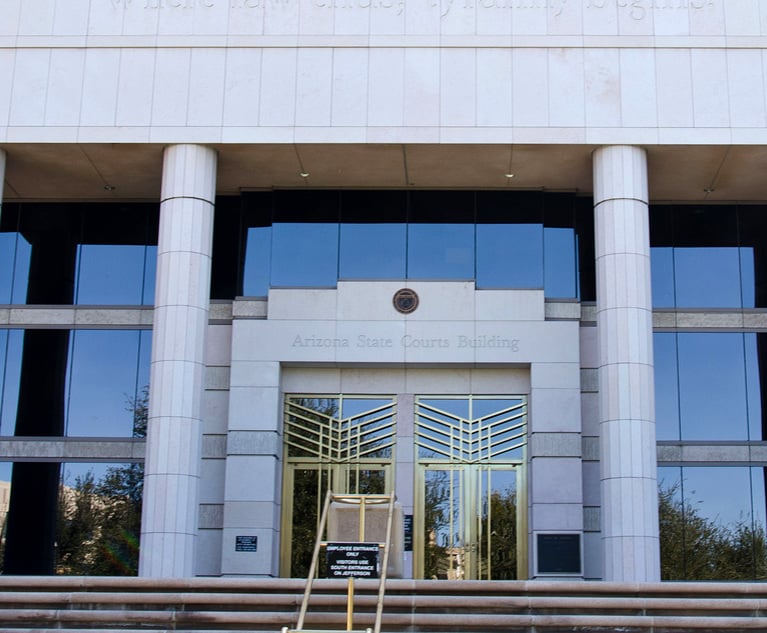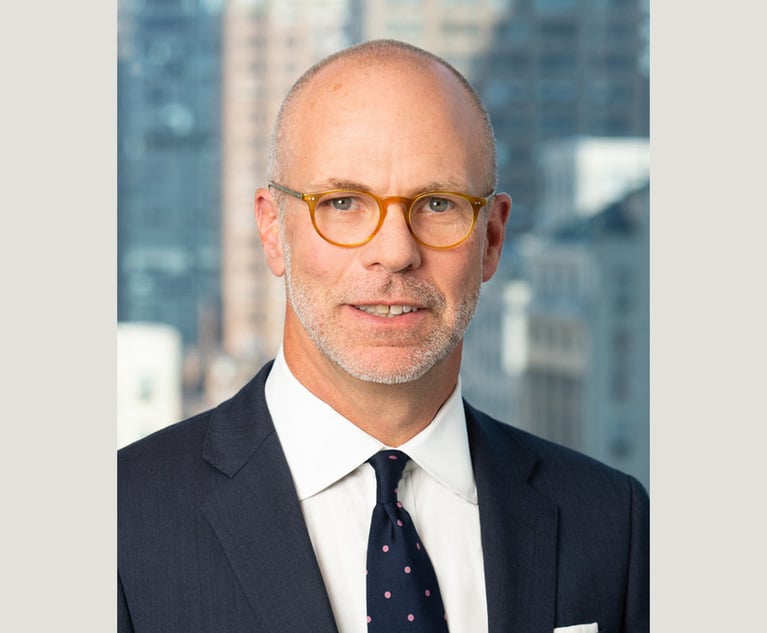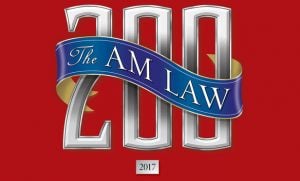The hollow middle: the US firms struggling to establish their unique selling point
If you aren't high-end or super cheap, are you a firm clients will come to? This year's Am Law 200 rankings highlight the challenges facing middle-ground US law firms
May 25, 2017 at 03:21 AM
11 minute read
The original version of this story was published on Law.com
The Am Law 200 reversed course in 2016, posting gains in gross revenue after experiencing a decline in 2015. But that average gain of 1.2%, coupled with similar increases in revenue per lawyer and profits per equity partner, masked some weakness in many firms' results. As this analysis shows, a 'hollow middle' is emerging
To get a grip on the market trend some observers hold responsible for flatlining the finance charts for the Am Law Second Hundred – the US firms that ranked 101-200 on our list of the nation's highest-grossing firms – ponder alcohol pricing.
Buyers who seek the best will pay $1,400 for a bottle of Moet & Chandon Bi Centenary Cuvee Dry Imperial from 1943, but the throngs who want their drink on the cheap want to drop only $6.99 for their six-pack of Budweiser.
The Second Hundred firms fall precariously in the middle of a market that on one hand serves clients who, like those who sip Moet & Chandon, are willing to pay dearly for what they consider high-end distinguished lawyering, and those on the other hand who serve clients like the Budweiser fans, who seek rock-bottom prices for the everyday stuff.
How does that bode for the most recently reported 2016 finances of Second Hundred firms, most of which occupy the middle-ground pricing ranges? Not well. They showed little signs of revenue or profit growth in 2016.
Last year, revenue per lawyer (RPL) and profits per equity partner (PEP) remained roughly flat, on average, for the Second Hundred. RPL increased 1.5% from the previous year to $658,989, while PEP inched up 1.6% to $748,960. The Am Law 100′s average RPL rose only 1.5%, but the roster's PEP average rose 3%.
The closer firms landed to the middle of the 1-200 rankings, the less gross revenue growth they achieved, on average. Divided into quartiles based on gross revenue performance in 2016, firms in the Second Hundred's top two quartiles performed worse than the bottom two quartiles in revenue growth. Gross revenue increased 0.3% to $7.092bn at firms 101-125, and increased 0.8% at firms 126-150. However, it rose 2.27% at firms 151-175 and 2.78% at firms 176-200. (Please note, we are comparing 2016 gross revenue for each quartile to the gross revenue for the same quartile – not necessarily the same firms – for 2015.)
"The hollow middle" is the term chosen by Bruce MacEwen, a lawyer and New York-based law firm consultant at Adam Smith Esq, to describe the firms that are not at the top, not at the bottom, and that are suffering slow growth as a result. As with all sorts of other markets, the providers of law services face risks if they appear to be offering otherwise undistinguished services without giving deep discounts, MacEwen says.
"There is relentless client pressure on rates and fees and it seems to ratchet up each year," MacEwen says.
Kent Zimmermann, a law firm consultant at The Zeughauser Group, agrees that rate pressure, which is occurring across almost all practice areas, industry sectors and geographies, accounts for much of the slow-growth risk. An overabundance of lawyers, however, also contributes to the challenges for the "hollow middle", he says. "Too many lawyers and not enough work to go around. It's expensive overcapacity at a lot of firms" – particularly pronounced among non-equity partners, Zimmermann says.
"For too many firms, the non-equity class has become a dumping ground for people who don't perform at the level the firm expects. They don't bill the hours or they don't originate," Zimmermann says. "The highest performing firms, when considering people for non-equity, allow into the class people who are coming up and down, not just people who are not cutting it."
The middle-ground firms suffering slow growth also often fail to stay disciplined about the kind of work they will take, he says. They are often so eager to keep lawyers busy that they take assignments or pursue practice areas for which clients are not willing to pay profitable amounts, Zimmermann says. Firms may even have to reduce their lawyer rosters to thrive. "If you look historically at firms that have become more profitable, often it involved shrinking headcount. It might be counterintuitive, but many firms have an opportunity to shrink to grow stronger financially," Zimmermann says.
"Differentiation" is the growth-strategy watchword most often repeated by Zimmermann, MacEwen, other consultants, and, perhaps most persuasively, lawyers leading firms with 2016 revenues that make their finances stand out as bright spots in a year of greys. Firms in the middle have to differentiate themselves by becoming known as experts in specialised practice areas, particular industries, or specific regions, these lawyers and consultants stress.
"It was a challenging year for them," Gretta Rusanow, head of advisory services for the law firm group at Citi Private Bank, says of The Am Law 200. But not all firms saw slow growth, she notes. "What is the difference about the haves and have-nots is having a differentiated brand. You want when the client comes to you, it's not about price. Instead, they are looking for the highest value in a given practice," Rusanow says.
"Clients through their buying behaviour are pushing many firms towards specialisation in some niche," Zimmermann says. "That's when the clients are willing to pay the firms' higher rates."
A handful of Am Law 200 Firms on the 2016 list that did achieve double-digit growth in gross revenue also appear to have successfully executed strategies to differentiate their law practices. Among those are: Lewis Roca Rothgerber Christie, which reported $159m in revenues in 2016, a 27.7% increase from the previous year; Greenspoon Marder, which reported $122.5m in revenues, a 17.2% increase; Curtis Mallet-Prevost Colt & Mosle, which reported $177m in revenues, a 16.8% increase; and Dickinson Wright, which reported $209m in revenues, a 12.7% increase.
Three years ago, his firm "put together a strategic plan that focused on areas of excellence," says Kenneth Van Winkle, managing partner for Lewis Roca, where RPL was $635,000 and the PEP came in at $605,000 in 2016. The firm, which had 251 lawyers and 111 equity partners in 2016, moved up 10 rungs on the rankings to 163. It focuses on representing religious institutions, including the Catholic Church, and gaming industry companies, and has an intellectual property (IP) practice it developed further in early 2016 when it merged with Christie Parker & Hale, adding more patent lawyers to work with the firm's litigators.
Executing such a plan and sticking to it was not easy. "We didn't go to business school. We are lawyers first," Van Winkle says.
Greenspoon Marder's speciality has historically been real estate, but now the firm has added cannabis. Fuelled in part by its investment in the industry, the firm moved up 11 spots on the rankings this year to 176 and expanded its IP and complex litigation practices. Greenspoon Marder's RPL declined 5.3% to $620,000 and its PEP grew 10% to $595,000 in 2016, as the firm expanded in both corporate work and in the national legalised marijuana sphere, adding 59 lawyers and opening in five new cities.
Curtis Mallet-Prevost Colt & Mosle's differentiator is its highly successful international arbitration practice, although it has achieved that status more organically than some firms, according to Al Lynch, its executive director. His firm, which moved up nine rungs in the rankings to 154th after a 16.8% jump in revenue, manages to compete against firms "four or five times our size", Lynch says, because of its laser focus on international arbitration. Curtis – which had $555,000 in RPL and $1.265m in PEP in 2016 – bolsters that practice with its 17 worldwide offices, including several in places frequented by few other international firms: Almaty and Astana in Kazakhstan, Ashgabat inTurkmenistan, Buenos Aires in Argentina, and Muscat in Oman.
"It really kind of took off," Lynch says, adding that the firm has received new assignments for Ghana and Libya. "The whole arbitration scene has been a good place."
There is relentless client pressure on rates and fees and it seems to ratchet up each year
Dickinson Wright, which had 411 lawyers and 123 equity partners in 2016, moved up nine rungs on the rankings this year to 142, with an RPL of $510,00 and PEP of $550,000. CEO William Burgess credits his firm's "upticks" not only to specific practices – IP, healthcare, corporate, M&A and securities – but also to new offices in Austin, Texas, and Fort Lauderdale, Florida, where the lawyer rosters complemented the firm's existing business areas.
"We perceived that our existing clients' needs in terms of activity level would be enhanced by having Florida and Texas offices in particular," Burgess says.
"Our overarching guidepost is where can we provide efficiencies for our clients. We were consciously attempting to expand cybersecurity and white-collar, healthcare, IP and general corporate," Burgess says. "But what we look for is to be very aware of the value we provide. We don't want to pretend that we can offer the services that we are aren't experts [in]."
The price is right
Burgess, along with the consultants and the other firm leaders where differentiation strategies have succeeded, stresses that specialisation must be coupled with pricing tactics to keep profits rising. Burgess says his firm can provide added value because of its offices in the midwest and southwest. And about 25% of the firm's revenues are from alternatively billed sources.
"We work hard to manage our costs," Lewis Roca's Van Winkle says, and notes that his firm's southwestern offices also help drive expenses down. Cost containment efforts are the only possible response to survive the persistent client pressure to discount fees felt by all law firms these days, no matter how much they have differentiated themselves, Van Winkle says.
That doesn't always mean assigning matters to the cheapest lawyers, he says. "Sometimes putting the higher-cost lawyer who does it quicker makes more sense."
"Legal services should not be bundled with a one-rate-fits-all approach," according to Greenspoon and Marder.
But neither executing nor pricing a differentiated law practice should be deemed easy, says MacEwen of Adam Smith Esq. Firms shouldn't assume that they can hire a bunch of laterals with a speciality and call it a day, he says.
"You can spend gobs on laterals and then in three years they are gone," he says.
Pricing also takes more effort than many law firm leaders assume. MacEwen recalls getting a call from "a sophisticated New York firm", which faced a deadline the very next day for an RFP and was only asking for help at that point. "If they won that engagement, I bet they lost their shirt," MacEwen says. Am Law 200 firms often make the mistake of pricing services too low just to get work. "We call it suicidal pricing," says MacEwen's colleague at Adam Smith Esq, Janet Stanton.
Such mistakes have led to the near slump in the "hollow middle", Stanton says. "Right now there are a few winners [and] a whole lot more losers than there were historically," Stanton says of The Am Law 200.
Seven firms saw revenue drop by double digits last year. In that unhappy category: Munger Tolles & Olson, Hughes Hubbard & Reed, Irell & Manella, Carlton Fields Jorden Burt, Kaye Scholer, Porter Wright Morris & Arthur, and Schiff Hardin.
Stanton says some firms in the "hollow middle" face extinction even though average metrics for The Am Law 200 do not show a downturn. "We have to be careful of averages. They are quite deceptive. We are seeing just such differences among individual firms," she says. "The firms that have a distinction are doing better than a firm that has a destination of nothing at all," she adds.
NOT FOR REPRINT
© 2025 ALM Global, LLC, All Rights Reserved. Request academic re-use from www.copyright.com. All other uses, submit a request to [email protected]. For more information visit Asset & Logo Licensing.
You Might Like
View All
The Law Firm Disrupted: With KPMG's Proposed Entry, Arizona's Liberalized Legal Market is Getting Interesting

Big Company Insiders See Tech-Related Disputes Teed Up for 2025
Trending Stories
- 1SDNY US Attorney Damian Williams Lands at Paul Weiss
- 2Litigators of the Week: A Knockout Blow to Latest FCC Net Neutrality Rules After ‘Loper Bright’
- 3Litigator of the Week Runners-Up and Shout-Outs
- 4Norton Rose Sues South Africa Government Over Ethnicity Score System
- 5KMPG Wants to Provide Legal Services in the US. Now All Eyes Are on Their Big Four Peers
Who Got The Work
Michael G. Bongiorno, Andrew Scott Dulberg and Elizabeth E. Driscoll from Wilmer Cutler Pickering Hale and Dorr have stepped in to represent Symbotic Inc., an A.I.-enabled technology platform that focuses on increasing supply chain efficiency, and other defendants in a pending shareholder derivative lawsuit. The case, filed Oct. 2 in Massachusetts District Court by the Brown Law Firm on behalf of Stephen Austen, accuses certain officers and directors of misleading investors in regard to Symbotic's potential for margin growth by failing to disclose that the company was not equipped to timely deploy its systems or manage expenses through project delays. The case, assigned to U.S. District Judge Nathaniel M. Gorton, is 1:24-cv-12522, Austen v. Cohen et al.
Who Got The Work
Edmund Polubinski and Marie Killmond of Davis Polk & Wardwell have entered appearances for data platform software development company MongoDB and other defendants in a pending shareholder derivative lawsuit. The action, filed Oct. 7 in New York Southern District Court by the Brown Law Firm, accuses the company's directors and/or officers of falsely expressing confidence in the company’s restructuring of its sales incentive plan and downplaying the severity of decreases in its upfront commitments. The case is 1:24-cv-07594, Roy v. Ittycheria et al.
Who Got The Work
Amy O. Bruchs and Kurt F. Ellison of Michael Best & Friedrich have entered appearances for Epic Systems Corp. in a pending employment discrimination lawsuit. The suit was filed Sept. 7 in Wisconsin Western District Court by Levine Eisberner LLC and Siri & Glimstad on behalf of a project manager who claims that he was wrongfully terminated after applying for a religious exemption to the defendant's COVID-19 vaccine mandate. The case, assigned to U.S. Magistrate Judge Anita Marie Boor, is 3:24-cv-00630, Secker, Nathan v. Epic Systems Corporation.
Who Got The Work
David X. Sullivan, Thomas J. Finn and Gregory A. Hall from McCarter & English have entered appearances for Sunrun Installation Services in a pending civil rights lawsuit. The complaint was filed Sept. 4 in Connecticut District Court by attorney Robert M. Berke on behalf of former employee George Edward Steins, who was arrested and charged with employing an unregistered home improvement salesperson. The complaint alleges that had Sunrun informed the Connecticut Department of Consumer Protection that the plaintiff's employment had ended in 2017 and that he no longer held Sunrun's home improvement contractor license, he would not have been hit with charges, which were dismissed in May 2024. The case, assigned to U.S. District Judge Jeffrey A. Meyer, is 3:24-cv-01423, Steins v. Sunrun, Inc. et al.
Who Got The Work
Greenberg Traurig shareholder Joshua L. Raskin has entered an appearance for boohoo.com UK Ltd. in a pending patent infringement lawsuit. The suit, filed Sept. 3 in Texas Eastern District Court by Rozier Hardt McDonough on behalf of Alto Dynamics, asserts five patents related to an online shopping platform. The case, assigned to U.S. District Judge Rodney Gilstrap, is 2:24-cv-00719, Alto Dynamics, LLC v. boohoo.com UK Limited.
Featured Firms
Law Offices of Gary Martin Hays & Associates, P.C.
(470) 294-1674
Law Offices of Mark E. Salomone
(857) 444-6468
Smith & Hassler
(713) 739-1250











